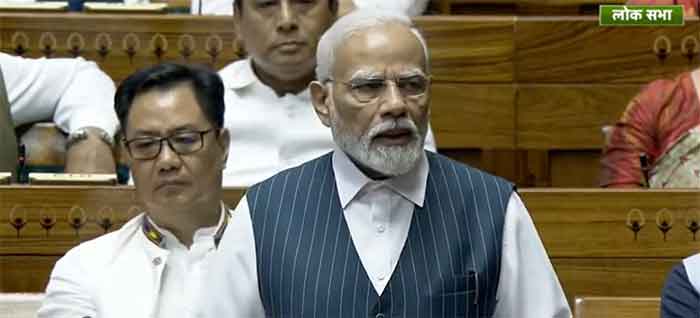
Notwithstanding the importance accorded to this special session of the Parliament, one is prompted to deliberate on what really is key purpose behind convening it? As per reports, the new Parliament was fully completed this year in May. Amid controversies, it was inaugurated by Prime Minister Narendra Modi on May 28. Several opposition parties boycotted this function as they felt the building should have been inaugurated by Indian President. Nevertheless, the issues chosen to be deliberated on during this special session could have been taken up in the monsoon session. Or the monsoon session could have been extended by a day or even few days to discuss these issues and to start proceedings in the new building. But as situation indicates, Modi and other BJP-stalwarts preferred holding a “special session” for these purposes as they wished to accord it “special” importance and apparently receive “special” media coverage for the same. If parliamentary elections were not around the corner, perhaps, “special” importance may not have been accorded to these moves. Perhaps.
The core reality of Modi being desirous of adding a special stamp of his identity to his moves cannot be ignored. His desire of being remembered in history for stepping into the new Parliament on September 19, 2023, is apparently one of these. His “special” address in the old building the preceding day followed by a special session of the union cabinet cannot also be missed as symbolic exercises directed towards probably boosting his own image. During his address, while remembering his predecessors, interestingly, he mentioned the first Prime Minister Jawaharlal Nehru’s name more than half-a-dozen times, as “Pandit Nehru” most often. He made special mention of the speech Nehru gave as India stepped towards independence from colonial powers. In his Tryst with Destiny speech, Nehru said, “At the stroke of the midnight hour, when the world sleeps, India will awake to life and freedom.” Taking note of his words, “at the stroke of midnight,” Modi said that this speech “will continue to inspire us.”
Irrespective of the degree to which Modi and his associates are “inspired” by Nehru’s speech, his mentioning it in his special address cannot be missed. When Nehru spoke, historically, it marked the dawn of a new era for India. From Modi’s perspective, stepping of Members of Parliament, led by him marks, at least symbolically, a “new beginning.” As he said, “With a new belief, new enthusiasm, and new energy, we are bidding farewell from here, ready to build the future.” In other words, he is hopeful of these words prompting voters to apparently exercise greater enthusiasm in ensuring his return to power. Nevertheless, one is prompted to deliberate on what should the relevance of his stay in power from 2014 onwards be understood as, if he is deliberating on building India/Bharat’s “future” from now onwards?
The same may be said about this government’s decision regarding Women’s Reservation Bill at virtually the fag end of its second term in power. Why didn’t it consider it seriously till now? If it had, probably, the Bill would have reached the stage of implementation by now, and there would be 181 women members in the next Lok Sabha. At present, it has 82. There is probably credibility in opinions questioning this ploy of the government and it being viewed more of an electoral exercise than being suggestive of Modi being serious on this front. Undeniably, the entire political drama has helped Modi remain in limelight. But chances of 33 percent quota for women in Parliament and State Legislatures actually becoming a law and being implemented seem remote till 2029. The next Census, which is likely in 2027, will be followed by redrawing of constituencies and then what may be viewed as only a proposal at present may turn into an electoral reality.
But if Modi and other leaders are really serious about ensuring greater participation of women in this political race, do they need to actually wait for implementation of this Bill? This Bill talks of only 33 percent quota for women and is expected to prevail only for 15 years. Why? Women constitute around 48 percent of the population. Their participation as voters in 2019 elections was 67.2 percent against 67 percent of men. Prominent women politicians from different parties have made their mark without relying on any reservation quota. These include Congress High Command Sonia Gandhi, West Bengal Chief Minister, TMC leader Mamata Bannerjee, Smriti Irani and Meenakshi Lekhi from ruling BJP, Mahua Moitra (TMC), Mayawati (BSP) and among others Supriya Sule (Nationalist Congress Party). If the reservation bill is ever implemented would these women politicians’ electoral race also be decided by it? So far it has not been. Perhaps, Modi needs to seriously consider this and ensure a greater share of women while selecting candidates for 2024 elections. Prior to that, a beginning could be made in ensuring this during forthcoming assembly elections. However, chances of this ever happening may probably be viewed as chasing a mirage.
But that ample hype has been raised about it during “special session” of the Parliament has probably served a major purpose of Modi. It has helped him gain substantial political attention as well as media coverage and also boosted his own image at least among his supporters. Clearly, the master strategist is exercising all possible communication strategies with eyes set on 2024!
Nilofar Suhrawardy is a senior journalist and writer with specialization in communication studies and nuclear diplomacy. She has come out with several books. These include:– Modi’s Victory, A Lesson for the Congress…? (2019); Arab Spring, Not Just a Mirage! (2019), Image and Substance, Modi’s First Year in Office (2015) and Ayodhya Without the Communal Stamp, In the Name of Indian Secularism (2006).










































